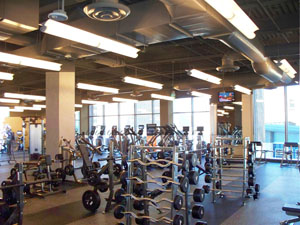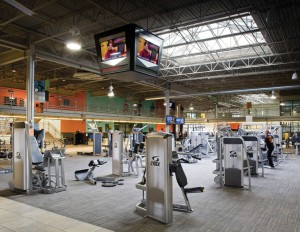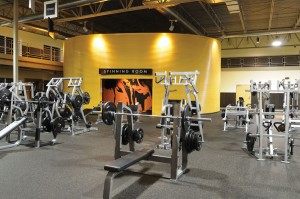
What was important 40 years ago is still important today. Yes, clubs have always ranked high with a cardio-focused style of exercise, but change over the years has resulted in more money and resources being placed into strength equipment. “There’s no, one perfect utopia; people get bored quickly,” said Todd Durkin, the owner of Fitness Quest 10 and Todd Durkin Enterprises. “Strength training is important because it offers diversity for our clients.”
Using Strength Training
“The truth is, strength training has captured a larger square footage of the club’s footprint,” said Ed Trainor, the vice president of fitness services and product development for Town Sports International. “There are a lot of components to free weights. They require a lot more square footage for flow and for safety.”
With everything spread out within the club, members can get lost in the jungle. Brian Johnson, the executive management with Urban Active, said it was best to get new members into beginner circuits. “We put first-time users in that area so we can educate them and show them the benefits of personal training,” he explained. “Even if the individual doesn’t want to work with a personal trainer, we feel it’s good to have that type of education so that they feel good in our facility.”
Not all members desire trainers explaining workouts to them. Many members want to be left alone and able to get on equipment and begin — clubs must remember that not every member will have a personal trainer. “The growth of consumers entering the fitness facilities will always have a large percentage of ‘self serve,’ or ‘I’m on my own’ individuals,” said Jeff Dilts, the product manager for Star Trac. “The need for intuitive-body-part based traditional-machine defined selectorized-training equipment allows for the clients to ‘get on and go’ with minimal adjustments or confusion and isolate body parts based on their goals, wants and needs in a basic program.”

Trainor said that TSI developed a concept many years ago that has allowed newer members to get into routines fairly quickly. “TSI invented a product called FitMap,” he said in reference to the concept. “It takes everything in our gym and color codes it blue, yellow and red. That means primary, secondary and advanced movements. Stable to unstable and machines and exercises are listed on our FitMap. What we are saying to our member is, we want to help you learn how to use our gym and if you learn how to use the gym you are going to get your results. That’s a great product and I would recommend that kind of protocol be followed with all new members — it should be required.”
Modern Strength Training
Strength training has made a drastic shift in the 40 years since the modern gym’s inception. “We are seeing a lot of functional strength training,” Trainor said. “About 10 percent of all your trainers are looking at suspension training. A lot of trainers are going to TRX and people are getting very creative with cable training.”
To maneuver the club accordingly, and allow for new types of functional training, the club must reposition other portions of the strength training family. “It’s possible that these new waves of training could erode free weights as we know them,” Trainor said. “You don’t need so many benches for arms and legs when the trainer is working them by doing pushups, lunges and so forth. The changing gym may see spaces opening up for that boot-camp-type training. It could squeeze strength and cardio areas a bit.”
Johnson believes the future will cause members to focus more on their core. “I think you have to incorporate a lot of functional training,” he said. “Functional movements and functional training; you have to have those pieces in your gym, that is your staple and you have to build pieces around that.”

“People are not as concerned with solely increasing their strength for the sake of being able to lift more weight, but for the purpose of leading a healthier, injury-free life,” said Sean Gagnon, the vice president of the Ab Coaster Company. “People are living longer and want to be able to enjoy their years. Strength training has evolved in leaps and bounds over the years, yet the principles of training remain the same. There is always going to be a new machine or method for performing an exercise, but the laws of exercise science are timeless.”
The “Other” Ideas
Strength training is going to constantly change. Every few years the club can expect a TV show to come out that gives consumers a new idea on getting healthy.
At the turn of the millennium exercise had a lot to do with cardio. In the ‘90s exercise was built almost entirely on group exercise and aerobics classes – everyone on the planet went to aerobics classes. Well almost, not those members that stuck with the regular free-weights and strength training.
Basically, the club’s free weights have been the one consistent aspect of the gym. It probably won’t ever be completely overshadowed by different exercise concepts. It’s true, the free-weight area may shrink as more and more people get involved in health clubs, but the free weights will need to exist to be implemented in all types of functional training.
But, what can the club use the free weights for? Brent Brentham, the president of Hydra-Gym said strength training in a club is necessary because it allows members to overload the muscular system and to create the necessary physiological changes to create strength, power and aerobic conditioning.
“Over the past 30 years there has been a consistent movement to functional training,” Brent said. “From free weights to Universal Gym, Mini Gym, Cybex, Nautilus, etc., everything has been getting more specific every year. From programs to equipment, the training that one is doing will have a positive impact on their lifestyle or hobbies and the member can feel and embrace as an activity that they do three to five times a week.”
Many clubs are starting to push members the way they would professional athletes. “Some of the changes that I see coming in the future are more fusion training and high intensity interval training with not only athletes, but clients of every fitness level,” Durkin said. “More trainers will start incorporating advanced training principles and sports performance models with the everyday Joe and Jane. Also, I see more total body conditioning programming using multidimensional movements versus isolated exercises. Bodyweight will continue to be used as a basis for all strength/movement training.”
Considering cardiovascular exercise was such a big hit, members are looking for a way to tone up, but get the same benefits as running on a treadmill. A lot of times, the new functional training systems will allow members to get their strength training in and boost their heart rate in the same exercise.
Trainor believes the idea of cardio and strength training we have grown accustomed to will continue to shrink into the future with clients demanding new types of exercises. “Right now, people are getting smarter and the new progressions in training are in no way making selectorized machines obsolete,” Trainor explained. “Once you build the core strength, then you can step them up to balance and functional training.”
Functional training has allowed for cardio and strength training to combine. Trainor said this mixture has made exercise fun for people. “Every time I’ve ever done an obstacle course, I’ve had fun and wondered how I could get better at it,” he said. “I think functional training has brought out the kid in all of us and that is the attraction. All the squatting and benching gets old.”
On top of the functional training, Trainor has seen other transition with the advent Total Body Vibration and Power Plate workouts. He said that they have given another dynamic to strength training and should allow people to work twice as hard when they begin their workouts by stretching on Powerplate and incorporating vibration prior to exercising. “We see our mode of training as a standalone strength training application or as a tool that is integrated with others during workouts,” said Tony Swain, the training and education manager for Power Plate. “The Power Plate machine is a strength training tool that has additional benefits for stretch, balance, core and massage.”
Strength training has proven the test of time and isn’t going to move out of the club. Cardio areas may shrink and free weights may be moved off to the side, but both still provide an integral part of training within the club. The goal for the future of the industry will be to figure out the proper use of all pieces within training and how they fit within the club. -CS








